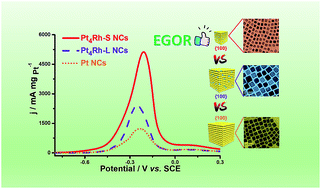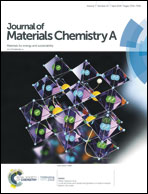Precursor-mediated size tuning of monodisperse PtRh nanocubes as efficient electrocatalysts for ethylene glycol oxidation†
Abstract
The tailoring and design of electrocatalysts, such as Pt-based nanocubes (NCs) covered by {100} facets, have received extensive attention in the past decade; however, studies on the facile yet precise synthesis of PtRh NCs with different sizes have rarely been reported up till now. Herein, a reliable method is reported for the first time to synthesize PtRh-small (PtRh-S) and PtRh-large (PtRh-L) NCs with the different sizes of 5.5 and 10.5 nm by introducing rhodium acetate and rhodium chloride, respectively. In particular, to the best of our knowledge, the PtRh-S NCs are the smallest synthesized PtRh NCs reported to date. We demonstrated that the {100} facet-covered PtRh NCs showed much better catalytic activity and stability than the {100}-terminated pure Pt NCs towards the ethylene glycol oxidation reaction (EGOR). Specifically, the size-optimized PtRh-S NCs show a much higher mass and specific activity (5125.0 mA mg−1 and 11.6 mA cm−2) for EGOR, which are 4.2 and 2.0 and 4.7 and 6.4-fold higher than those of the Pt NCs and Pt/C catalysts, respectively. The monodisperse nanocubic structure, ultra-small size and alloy effect led to the enhanced electrocatalytic behaviors. The present study describes the rational synthesis of size-controlled PtRh NCs and further provides a promising reference for the effective manipulation of other cubic nanocatalysts for applications in fuel cells and so forth.

- This article is part of the themed collection: 2019 Journal of Materials Chemistry A Most Popular Articles


 Please wait while we load your content...
Please wait while we load your content...